Video of the Week:
Hydrangea Macrophylla
Turfgrass:
Fertilize Irrigated Cool-Season Lawns in May
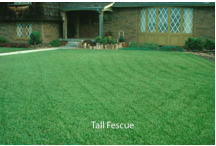
May is a good time to fertilize because the springtime flush of growth characteristic of these grasses has tapered off, so the fertilizer you apply will be less likely to cause excessive shoot growth than if you fertilized at a full rate in April. Slow-release nitrogen sources are ideal. These nitrogen sources promote controlled growth, which is desirable as the stressful summer weather approaches. Relatively few fertilizers available to the homeowner supply ALL of the nitrogen in the slowly available form. But one such product that is widely available is Milorganite. Other such products available in the retail market include cottonseed meal, alfalfa-based fertilizers, and any other products derived from plants or animals. (Bloodmeal is an exception, and contrary to popular belief, the nitrogen it supplies is quickly available.) These products are all examples of natural organic fertilizers. They typically contain less than 10 percent nitrogen by weight, so compared to most synthetic fertilizers, more product must be applied to get the same amount of nitrogen. Translation: they are more expensive! Apply enough to give the lawn one pound of nitrogen per 1,000 square feet. For example, if the fertilizer is 6 percent nitrogen by weight, you will need to apply almost 17 pounds of fertilizer product per 1,000 square feet. Summer lawn fertilizers that contain at least a portion of the nitrogen as slow-release are fine to use as well. Be sure to follow label directions. If cost is prohibitive, you can use the less expensive quick-release (i.e., soluble) sources, but split the application into two doses as follows: apply enough to give the lawn 0.5 lb nitrogen per 1,000 square feet in May and again in early June. (Ward Upham)
Fruit:
Be on the Lookout for Peach Leaf Curl and Plum Pocket
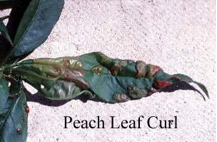
Trees that are severely infected with peach leaf curl are likely to lose many leaves. If trees are healthy, new leaves will grow. Indicators of a healthy tree are large, deep green leaves and last year's growth being at least 18 to 24 inches long. If these tree vigor indicators are not present, especially if there was only 12 inches or less of growth last year, then a fertilizer application would be helpful.
The fertilizer should be spread on the soil under the branch area. Apply 1 and 1/3 to 2 cups of a 13-13-13 fertilizer under the branch area. If a soil test indicates that only nitrogen is needed, use 1/3 to 1½ cups of nitrate of soda (16-0-0) instead of the 13-13-13. You may also substitute a high nitrogen fertilizer such as a 27-3-4, 30-5-4 or something similar for the 13-13-13, but use only half the amount used for nitrate of soda. The sooner fertilizer is applied, the more immediate benefit it will have in promoting new leaf growth. Both peach leaf curl and plum pocket can be controlled with a single fungicide application applied this fall after leaf drop or early next spring before bud swell.
Effective fungicides include Bordeaux mixture and chlorothalonil (Bravo, Daconil and others). Be sure to cover the entire tree including the bark and trunk. (Ward Upham)
Fruit Sprays and Spray Water pH

However, if the water you use has a pH of 10, half the captan will break down in 2 minutes. Malathion isn’t nearly as sensitive but still will break down under high pH conditions though it is stable at a pH between 5 and 7. Note that alkaline hydrolysis does not affect all pesticides. Captan is the exception, not the rule.
So, how do you bring down the pH of your spray water if it is high? Commercial people use buffering agents but that may be difficult for homeowners to find. Food grade citric acid can help. If you have a pH of 8.0, add 2 ounces of this citric acid per 100 gallons of water (1 and 1/4 teaspoons per 10 gallons) to bring the pH down to about 5.5. (Ward Upham)
Peaches and Apricots
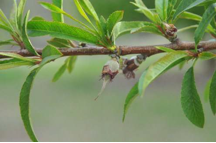
Control insects and diseases: Though it is too late to control peach leaf curl (see http://www.hfrr.ksu.edu/doc3168.ashx ), it is possible to control scab and brown rot. Insects of concern are plum curculio, oriental fruit moth, plant bugs, and stink bugs. Use Captan or Immunox to control the diseases, and malathion to control the insects. Spray every 10 to 14 days. Pay attention to the waiting period between the last spray and harvest. See the publication, “Fruit Pest Control for Home Gardens” at http://www.ksre.ksu.edu/bookstore/pubs/c592.pdf for details including organic controls.
Thin peaches: Thin peaches to 1 every 6 to 8 inches to maximize fruit size and to decrease the load on the branches. As a general rule, we need about 40 leaves per peach for maximum quality. Peaches are borne in clusters, so calculate how many a branch can support by dividing the length of the branch in inches by 7. As long as there is an average of 7 inches of branch length per peach, it doesn’t matter whether the peaches are in clusters or not.
Water Trees as Needed: The most critical time for adequate water is during the pit hardening stage which usually lasts between 2 to 4 weeks. Cut open a few peaches to determine when the pit starts to harden or become woody. Irregular watering during this period can lead to split peaches.
Prop up branches if needed: Prop up branches if the fruit load is so heavy the tree may break apart. Use boards with a “V” cut in one end to support the branch. Prune the branch back to a smaller side branch next spring (March). (Ward Upham)
Flowers:
Blackspot of Roses
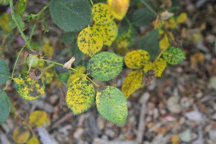
The infection usually starts on the lower leaves and works its way up the plant. Blackspot is most severe under conditions of high relative humidity (>85%), warm temperatures (75 to 85 degrees F) and six or more hours of leaf wetness. Newly expanding leaves are most vulnerable to infection. The fungus can survive on fallen leaves or canes and is disseminated primarily by splashing water.
Cultural practices are the first line of defense.
1. Don't plant susceptible roses unless you are willing to use fungicide sprays. For a list of blackspot resistant varieties, go to: http://www.ppdl.purdue.edu/ppdl/weeklypics/3-22-04.html
2. Keep irrigation water off the foliage. Drip irrigation works well with roses.
3. Plant roses in sun in areas with good air movement to limit the amount of time the foliage is wet.
4. Remove diseased leaves that have fallen and prune out infected rose canes to minimize inoculum.
If needed, protect foliage with a regular spray program (10- to 14-day schedule) of effective fungicides. Recommended fungicides include tebuconazole (Bayer Disease Control for Roses, Flowers and Shrubs), myclobutanil (Immunox, Immunox Plus), triticonazole (Ortho Rose & Flower Disease Control) and chlorothalonil (Broad Spectrum Fungicide, Garden Disease Control, others). (Ward Upham)
Miscellaneous:
Excessive Rain Can Cause Leaf Problems
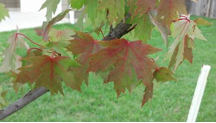
This lack of oxygen to the roots often results in a yellowing of foliage. In certain plants such as oaks and maples, however, it may also lead to a reddening of some of the newer leaves. Fortunately, color changes due to wet soils will be corrected as soils dry. Plants should regain their color when we return to more normal weather.
Trees Shedding Leaves: If trees shed leaves in a general shedding with all parts of the tree losing some leaves, then there is no cause for concern. A general shedding of the leaves is most often due to weather turning hot and dry. The tree drops leaves because the root system can no longer keep up. Dropping leaves helps balance the amount of water available from the root system and the amount needed by the leaves.
However, the same thing can happen if the soil is too wet. A lack of oxygen in the soil compromises the root system so it can no longer support all the leaves. Therefore, the tree drops some leaves to bring the tree roots and leaves back into balance. The tree will retain more than enough leaves to remain healthy. (Ward Upham)
Recent Rains Trigger Mushroom Development
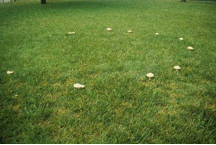
Unfortunately, the thick fungal mat formed by the fungus interferes with water infiltration. The fungus also may release certain byproducts that are toxic to the turf. This can lead to dieback of the turf close to the ring. Fairy rings are difficult to control. You can sometimes eliminate the ring by digging to a depth of 6 to 12 inches and 12 inches wide on both sides of the ring, refilling the hole with non-infested soil. Or you can try to mask the symptoms by fertilizing the rest of the lawn so that it is as dark green as the ring. This often isn't a good idea because it tends to promote other turf problems. Commercial people can use certain fungicides to control fairy rings but these products are not available to homeowners. See http://www.ksre.ksu.edu/bookstore/pubs/EP155.pdf for more info on these fungicides.
Some mushrooms in lawns are not associated with fairy rings. These may be mycorrhizal (symbiotic association with tree roots) or saprophytic (live on dead organic matter such as wood, etc.) in the soil. Because some of these mushrooms are beneficial, you don't really want to kill them. Besides, a fungicide spray to the mushroom itself does little good. Remember the mushroom is simply the fruiting structure of the organism. Most of the fungus is below ground and inaccessible to the chemical. If mushrooms are a nuisance, pick them and dispose of them as soon as they appear. Remove sources of large organic debris from the soil. Also, mushrooms tend to go away as soil dries. Patience may be the best control. Some of the mushrooms in the lawn are edible, but others are poisonous. Never eat mushrooms unless you are sure of their identity. (Ward Upham)
Pests:
Aphids
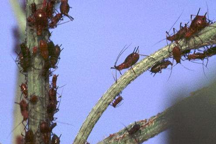
Aphids feed by sucking sap from buds, leaves, twigs and developing fruit. Most of that sap is passed through their body and ejected through two small “pipes” known as cornicles that project from the rear of their bodies. This ejected, sticky
material is called honeydew. This honeydew often becomes black with sooty mold fungus. Automobiles parked under trees with large aphid populations will often be spotted with honeydew. Though the finish will not be harmed by the honeydew, it is a hassle to clean off.
Aphids usually are controlled effectively by nature. Adverse weather conditions such as beating rains and low temperatures, as well as fungus diseases, insect predators and parasites, keep the aphids in check. Aphid enemies include lady beetles, syrphid fly larvae, aphis lions and small wasp parasites known as braconids.
Most insecticide applications destroy beneficial insects as well as pests and leave trees or shrubs unprotected if pest resurgence occurs. Because beneficial insects play an important role in natural aphid control, try washing aphids away with a forceful stream of water (if practical) before using insecticide sprays.
If control measures are warranted, use insecticidal soaps, horticultural oils, malathion, cyfluthrin or permethrin. Reapplication may be needed. Imidacloprid (Annual Tree and Shrub Insect Control, 12 Month Tree & Shrub Insect Control, Max Tree and Shrub Insect Control, Bonide Systemic Granules IC, Bayer Tree and Shrub Insect Control) is a systemic insecticide that can be used to prevent aphid populations from building but must by applied early to allow time for the pesticide to move to the new growth. This time period may vary from one week to three months depending on the size of the plant with very large trees taking the most time. (Ward Upham)
Sawfly Larvae on Ash
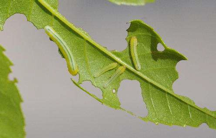
These sawfly larvae are a light green color with a broad, whitish stripe on the top side. In the middle of the whitish stripe there appears to be a darker green stripe that is actually the digestive tract of the insect. Though sawfly larvae resemble caterpillars, they have at least six pairs of "stublike" prolegs behind the three pairs of true legs on their abdomen. (Caterpillars never have more than five pairs of prolegs.)
There are usually no detrimental effects to the health of the tree if nature is allowed to run its course. Even if all the leaves are eaten, it is early enough in the growing season for trees to put out a complete new set of leaves and still has enough time to make all the food reserves needed to survive the coming winter. However, if control is desired, a number of insecticides can be used for control including cyfluthrin (Bayer Lawn and Garden Multi-Insect Killer), malathion, esfenvalerate (Monterey Bug Buster II) and carbaryl (Sevin). An effective organic product is spinosad (Captain Jack’s Deadbug Brew; Fertilome Borer, Bagworm, Leafminer and Tent Caterpillar Spray; Monterey Garden Insect Spray). Horticultural oils and insecticidal soaps are also effective because of the soft skin of sawfly larvae. (Ward Upham)
Contributors: Ward Upham, Extension Associate
 RSS Feed
RSS Feed
